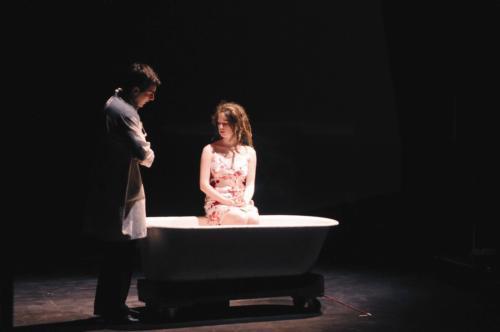
News
Summers Will Not Finish Semester of Teaching as Harvard Investigates Epstein Ties

News
Harvard College Students Report Favoring Divestment from Israel in HUA Survey

News
‘He Should Resign’: Harvard Undergrads Take Hard Line Against Summers Over Epstein Scandal

News
Harvard To Launch New Investigation Into Epstein’s Ties to Summers, Other University Affiliates

News
Harvard Students To Vote on Divestment From Israel in Inaugural HUA Election Survey
Dualities in 'Space Between'

For the first time in 15 years, a student-written play is premiering on the Loeb Mainstage. This honor has opened artistic possibilities for the producers, actors, and all others involved. The Harvard-Radcliffe Dramatic Club’s “The Space Between” will use the space to produce an experimental play combining theatrics, dance, and, less likely, physics.
Catherine “Calla” Videt ’09, playwright and director of the play, who could not be reached for comment, wrote the work as the second half of her thesis for her Special Concentration in Theatre and Physics. She started developing the project as a freshman, inspired by the beauty of physics. Videt, along with Ilinca Radulian ’10, applied to produce the play with HRDC last semester, and they were granted the second Loeb Mainstage slot of the spring season.
“The Space Between” is an exploration of how to make theoretical physics manifest on stage. Inspired by the late Samuel Beckett, the play lacks a traditional form. Instead, it is divided into the intertwining stories of different couples who act almost as analogous pairs. The principle couple is Richard Feynman, the Caltech physicist who helped develop the atomic bomb, and his wife, who in this play is called Eurydice. Both are dying and reflecting on their youth. Another story involves a Biblical Adam and Eve, echoed by a modern Adam, a painter, and Eve, his lover and one of Feynman’s students. The final thread involves the mythical Orpheus and Eurydice. Through these couples, the play expresses the laws of physics and the intangible, dual themes of death and passionate love. As the play progresses, the characters move in and out of reality.
These stories act as explanations for the theories of physics, including wave-particle duality.
“The theme of seeing, of turning back to see, of interrogating the past for answers keeps coming back through the play,” Radulian wrote in an email. “The physical concept of collapsing the wave function through observation is paralleled with the Orpheus story. If you don’t look, both choices are still possible; ‘yes’ and ‘no’ exist and are valid at the same time. If you look, one of the possibilities vanishes. This is an accessible explanation of the physical concept, which the Orpheus myth follows entirely.”
Executive producer Kevin J. Davies ’10 agreed that the play celebrates the beauty of physical laws. “[‘The Space Between’] began as an exploration of what staging physics would be like through dancing, [and] sound video,” Davies says. “It’s about taking an equation that you can write on a wall and making it into something that you can hear and see and even sometimes touch.”
In order to realize this goal, the play incorporates many forms of media, such as video, trapeze, and dance. “It’s also an incredibly beautiful show. There’s trapeze, video… it’s very lush,” Jesse W. Barron ’09, who plays Richard Feynman in the show. “It’s very multimedia and all about possibility.”
The production staff of “The Space Between” have all influenced the energy and direction of the play and taken the opportunity to experiment with and explore the possibilities being on the American Repertory Theater’s Mainstage provides.
As such, the production has taken on a collaborative dimension, with the experienced production staff adding their own creative vision to Videt’s text. The result is in an organic, malleable, multifaceted whole that represents the artistic visions of a group, not one individual.
“Most plays start from the text and build from that. They extrapolate from something that’s really defined and set,” Davies says. “Because with this show there wasn’t an original structure, we’ve been able to edit and refine as the show evolves.”
The production has evolved in a manner similar to the theories and lovers it incorporates and describes. The final product will run on the Loeb Mainstage today through May 2nd.
Want to keep up with breaking news? Subscribe to our email newsletter.
